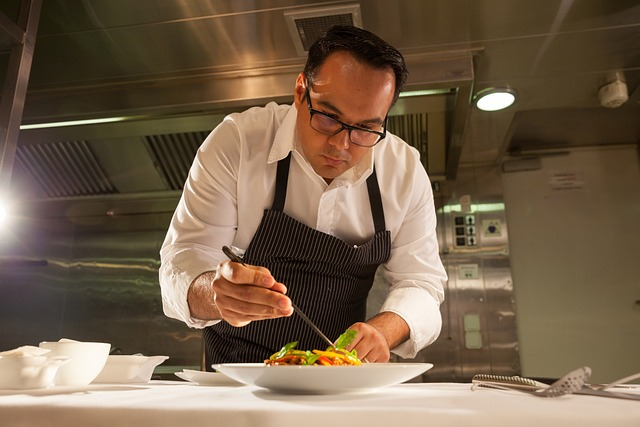To successfully open restaurant doors is a dream for many aspiring business owners. The thrill of opening your very own restaurant is real, but it requires careful planning and execution.
However, the journey from concept to a grand opening involves a number of really important steps, each crucial to the success of your venture.
This guide will walk you through everything you need to know to open a restaurant, from initial planning to welcoming your first customers. A detailed business plan is essential as it helps identify potential challenges, understand the market and competition, and shape the restaurant’s concept and operations.
Drawing on insights from business planning expert Nadine Connell of Smart Business Plans, we’ll ensure you’re well-prepared to tackle the challenges ahead.
Firstly, just one crucial question before you read any further: do you have training or work experience in the restaurant industry?

It’s advisable to start a culinary journey at a restaurant and study at a bachelor’s degree in hospitality management or equivalent. Experience in the hospitality industry is crucial before starting a restaurant business in Australia. Some of our current restaurant owners love food, but you’ll need more tools than passion to succeed. In fact 65% to 75% of new restaurants fail within their first year. Many of them result from lack of experience or training.
Ok – so you’re ready to move forward?
Here are the 10 steps in order you need to work through:
Step |
What you need to do |
Resources needed |
|---|---|---|
1. Concept Development |
Define your restaurant’s unique concept and target market |
Market research, creative brainstorming |
2. Location Selection |
Choose a location with high visibility and foot traffic |
Real estate agent, local market analysis |
3. Business Plan Creation |
Develop a comprehensive business plan for financing and operations |
Smart Business Plans, or try yourself |
4. Secure Financing |
Obtain the necessary funds through savings, loans, or investors |
Smart Business Plans can broker a loan for you |
5. Designing Layout |
Create a functional and attractive restaurant layout |
Interior designer, contractor |
6. Hiring Staff |
Recruit and train a skilled team |
HR specialist, training materials |
7. Marketing Strategy |
Develop a marketing plan to attract and retain customers |
Marketing consultant, advertising budget |
8. Legal Compliance |
Obtain all necessary licenses and permits |
Lawyer, local council resources |
9. Food Safety Implementation |
Establish food safety protocols and conduct regular inspections |
Training materials, inspection checklists |
10. Customer Engagement |
Build loyalty through exceptional service and community involvement |
CRM system, community events budget |
Let’s go through these steps in more detail below.
Understanding the Restaurant Industry Landscape
Before diving into the specifics of opening a restaurant, it’s essential to grasp the current state of the restaurant business. The industry is dynamic, with trends and consumer preferences evolving rapidly. According to Ibisworld, as of 2023 the size of the restaurant industry in Australia was approximately AUD $23 billion. The industry has been experiencing steady growth, driven by increasing consumer spending on dining out and a growing preference for unique dining experiences. The annual growth rate has been around 3-4% in recent years, though this can vary based on economic conditions and consumer trends.
Key Industry Trends
Several trends are shaping the restaurant industry today. These include the rise of plant-based diets, the growing demand for sustainable practices, and the increasing use of technology in operations. Staying ahead of these trends can give your restaurant a competitive edge.
Planning Your Open Restaurant Concept

Starting a food business begins with your restaurant concept, which is the foundation of your business. It dictates everything from your menu to your decor. Will you offer fine dining, casual eats, or a unique fusion cuisine? Nadine Connell advises, “Your concept should reflect your passion and stand out in the market. It’s what will draw customers to your door.”
Defining Your Unique Selling Proposition (USP)
Your USP is what sets your restaurant apart from the competition. It could be a signature dish, a unique dining experience, or exceptional customer service. Clearly defining your USP will help you attract and retain customers.
Conducting Market Research
Market research is critical. Analyse your local market to identify gaps that your restaurant can fill. Consider the demographics, spending habits, and preferences of your potential customers. Use tools like surveys and focus groups to gather data.
Choosing the Perfect Location for your own restaurant
Commercial space can make or break your restaurant. You’ll need a spot with high foot traffic, good visibility, and ample parking. Collaborate with a local real estate agent who specializes in commercial properties to find the ideal location. Connell emphasises, “Choosing the right location is one of the most important decisions you’ll make. It can significantly impact your restaurant’s success.”
Understanding Local Council Regulations
Each city has its own set of regulations for opening a restaurant. These can include zoning laws, health and safety codes, and building permits. “Working closely with your local council from the beginning can save you a lot of headaches later,” says Connell. Ensure you understand all the requirements and obtain the necessary approvals before proceeding.
Securing Financing for Restaurant Owners

Starting a restaurant requires substantial investment. You’ll need to cover costs like lease deposits, renovations, equipment, and initial inventory. Options for financing include personal savings, small business loans, bank loans, and investors. Connell suggests, “A well-drafted business plan is crucial when seeking financing. It shows lenders and investors that you’ve thought through every detail.”
Developing a Business Plan
Your restaurant business plan should outline your restaurant’s concept, target market, marketing strategy, financial projections, and operational plan. It’s not just for securing financing; it also serves as your roadmap to success. Include detailed financial forecasts and a clear strategy for reaching your target audience.
Designing Your Restaurant Layout
A well-designed layout enhances both customer experience and operational efficiency. Work with a professional designer to create a space that’s attractive and functional. Consider factors like kitchen layout, dining area flow, and accessibility. Make sure your layout complies with all local building codes and safety regulations.
Sourcing Equipment and Supplies
You’ll need everything from kitchen appliances to dining furniture. Source quality equipment that fits your budget. Establish relationships with reliable suppliers to ensure consistent delivery of fresh ingredients and other essentials. Negotiate favorable terms and consider bulk purchasing to reduce costs.
Crafting a Compelling Menu

Your menu is at the heart of your restaurant. It should reflect your concept and appeal to your target market. Offer a balance of familiar favorites and unique dishes that set you apart. “A well-curated menu can drive repeat business,” says Connell.
Menu Design and Layout
The design and layout of your menu are as important as the items themselves. A well-designed menu can enhance the dining experience and influence customer choices. Use professional design services to create a visually appealing and easy-to-read menu.
Pricing Your Menu Items
Pricing strategy is critical. You need to cover your costs and achieve a profit margin while remaining competitive. Consider food costs, labor, and overhead when setting prices. Regularly review your prices to ensure they reflect changes in costs and market conditions.
Creating Signature Dishes
Signature dishes can become your restaurant’s calling card. They should be unique, memorable, and aligned with your concept. Promote these dishes prominently on your menu and marketing materials. Encourage customer feedback to refine and perfect these offerings.
Hiring and Training Staff
Your staff are the face of your restaurant and are integral to the smooth running of your business operations. They play a crucial role in customer satisfaction and retention.
Recruiting the Right Team
Hire staff who are passionate about hospitality and aligned with your restaurant’s values. Conduct thorough interviews and check references. Consider the specific skills and experience needed for each role, from chefs to servers to managers.
Providing Comprehensive Training

Training should cover everything from menu knowledge to customer service skills. Invest time in training to ensure a smooth opening and ongoing operations. Regularly update training programs to reflect new practices and standards.
Implementing a Strong Management Structure
A strong management team can handle day-to-day operations and help you scale your business. Delegate responsibilities to capable managers to focus on strategic planning. Foster a positive work environment to retain top talent and reduce turnover.
Marketing Your Open Restaurant
Effective marketing drives awareness and attracts customers. Your strategy should encompass both online and offline channels.
Building a Strong Online Presence
In today’s digital age, a strong online presence is essential. Create a professional website with up-to-date information about your menu, hours, and location. Utilise social media platforms to engage with your audience and promote specials. Consider investing in online advertising to reach a broader audience.
Leveraging Local SEO
Optimise your online presence for local search. Ensure your restaurant appears in local business directories and map services. Encourage satisfied customers to leave positive reviews online. “Local SEO can significantly boost your visibility and attract more customers,” notes Connell.
Hosting a Memorable Grand Opening
A grand opening event can generate buzz and attract initial customers. Offer promotions, live entertainment, or special menus to make the event memorable. Invite local media and influencers to cover the event and spread the word.
Utilising Traditional Marketing

Don’t overlook traditional marketing methods. Flyers, local newspaper ads, and community events can be effective ways to reach potential customers. Partner with local businesses and organisations to cross-promote and build community connections.
Navigating the Legal and Financial Aspects
Understanding the legal and financial aspects of a restaurant startup is crucial for long-term success.
Registering Your Business
Register your restaurant as a legal entity. This might be a sole owner, partnership, or company. Consult with a lawyer to determine the best structure for your business. Ensure you comply with all tax requirements and keep accurate financial records.
Obtaining Necessary Licenses and Permits
You’ll need various licenses and permits to operate legally. These can include a business license, food service permit, and liquor license. Check with your local council for specific requirements. Staying compliant with regulations can prevent costly fines and disruptions.
Setting Up Accounting Systems
Implement a robust accounting system to track expenses, revenue, and profit margins. Use accounting software to simplify this process and ensure accuracy. Regularly review financial reports to make informed decisions and keep your business on track.
Managing Cash Flow
Cash flow management is critical, especially in the early stages. Monitor your cash flow closely and have a plan for covering unexpected expenses. Maintain a cash reserve and consider securing a line of credit for emergencies.
Maintaining High Standards of Food Safety and Hygiene
Food safety and hygiene are paramount in the restaurant industry. Non-compliance can lead to fines, closures, and damage to your reputation.
Implementing Food Safety Protocols
Develop and enforce strict food safety protocols. Train your staff on proper food handling, storage, and preparation techniques. Regularly review and update your protocols to reflect best practices and regulatory changes.
Conducting Regular Inspections
Regular inspections can help identify potential issues before they become major problems. Schedule routine internal audits and prepare for external health inspections. Keep detailed records of inspections and corrective actions taken.
Building Customer Loyalty

Repeat customers are vital to your restaurant’s success. Focus on building relationships and providing exceptional service.
Creating a Loyalty Program
A loyalty program rewards repeat customers and encourages them to return. Offer discounts, free items, or special events for members. Promote your loyalty program through your website, social media, and in-house signage.
Gathering and Acting on Customer Feedback
Encourage customers to provide feedback on their dining experience. Use this information to make improvements and show customers that you value their opinions. Regularly survey customers and implement changes based on their feedback.
Engaging with the Community
Engage with your local community through sponsorships, events, and partnerships. Building strong community ties can enhance your restaurant’s reputation and customer base. Participate in local festivals, support local charities, and collaborate with nearby businesses.
Monitoring and Adapting to Industry Trends
Staying ahead of industry trends can give your restaurant a competitive edge. Regularly review industry reports and adapt your strategy accordingly.
Adopting Technology

Technology can streamline operations and enhance the customer experience. Consider implementing online reservations, digital menus, and mobile payment options. Invest in a robust POS system to manage orders, inventory, and sales data efficiently.
Embracing Sustainability
Sustainability is increasingly important to consumers. Incorporate eco-friendly practices like sourcing local ingredients, reducing waste, and using sustainable packaging. Highlight your sustainability efforts in your marketing to attract environmentally conscious customers.
Offering Delivery and Takeout Options
With the growing demand for convenience, offering delivery and takeout options can boost your revenue. Partner with delivery services or set up your own delivery system. Ensure that your takeout packaging maintains the quality of your food.
Overcoming Common Challenges
Opening a restaurant comes with its share of challenges, but with a well developed business plan, you can start and grow a successful restaurant business. Being prepared can help you navigate these obstacles effectively.
Managing Operational Costs
Operational costs can quickly add up. Regularly review your expenses and find ways to reduce costs without compromising quality. Negotiate with suppliers, optimise your inventory, and implement energy-saving practices.
Handling Seasonal Variations
Seasonal variations can impact customer traffic and revenue. Plan for these fluctuations by adjusting your menu and marketing efforts accordingly. Offer seasonal specials and host events to attract customers during slower periods.
Dealing with Competition
Competition is fierce in the restaurant industry. Stay competitive by continually innovating and offering exceptional value. Monitor your competitors and identify areas where you can differentiate your restaurant.
Long-Term Growth and Expansion
Once your restaurant is established, consider opportunities for growth and expansion. The average restaurant owner in Australia typically spends a significant amount on upfront investments, including labor, food, and kitchen equipment.
Evaluating Expansion Opportunities
Evaluate opportunities for opening additional locations or franchising your concept. Conduct thorough market research to ensure demand in new markets. Develop a detailed expansion plan and secure the necessary financing.
Scaling Your Business

Scaling requires careful planning and investment. Ensure you have the resources and infrastructure in place to support growth. Invest in staff training and standardised procedures to maintain quality across locations.
Maintaining Quality and Consistency
As you grow, maintaining quality and consistency is crucial. Implement standardised procedures and regular training to ensure all locations meet your high standards. Regularly visit each location to oversee operations and address any issues.
What next?
Opening a restaurant is a challenging but rewarding endeavor. By following this comprehensive guide you can set your restaurant up for success. Remember, thorough planning, attention to detail, and a commitment to excellence are your keys to thriving in the competitive restaurant industry.
Talk to the team at Smart Business Plans Australia for business planning and business finance help.

